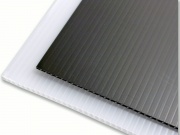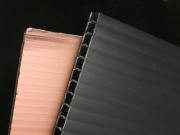Difference between revisions of "Coroplast"
| (12 intermediate revisions by the same user not shown) | |||
| Line 6: | Line 6: | ||
== Synonyms and Related Terms == | == Synonyms and Related Terms == | ||
| − | + | Silmilar products: Polyflute | |
| − | |||
[[File:coroplast staticintercept2.jpg|thumb|Coroplast]] | [[File:coroplast staticintercept2.jpg|thumb|Coroplast]] | ||
== Applications == | == Applications == | ||
* Enclosures and frames | * Enclosures and frames | ||
| − | * Backing and support | + | * Storage boxes and trays |
| + | * Backing, lining and support | ||
== Personal Risks == | == Personal Risks == | ||
| − | Coroplast® is combustible and may release harmful toxins at temperatures of 600 degrees F. See Coroplast® health and safety sheet [[https://www.coroplast.com/wp-content/uploads/Health-and-Safety-Coroplast.pdf]] | + | Coroplast® is combustible and may release harmful toxins at temperatures of 600 degrees F. |
| + | |||
| + | See Coroplast® health and safety sheet [[https://www.coroplast.com/wp-content/uploads/Health-and-Safety-Coroplast.pdf]] | ||
== Collection Risks == | == Collection Risks == | ||
| Line 23: | Line 25: | ||
== Physical and Chemical Properties == | == Physical and Chemical Properties == | ||
| − | + | Sheets that are 4 mm thick will not burst on Mullen tester. May degrade in sunlight. | |
| − | |||
{| class="wikitable" | {| class="wikitable" | ||
|- | |- | ||
| Line 42: | Line 43: | ||
Available in a variety of thicknesses ranging from 2-6 mm. | Available in a variety of thicknesses ranging from 2-6 mm. | ||
| − | == | + | == Resources and Citations == |
| + | |||
| + | * Preservation Equipment: [http://www.preservationequipment.com Website] | ||
| − | Preservation | + | * Rachael Perkins Arenstein, Lisa Goldberg, and Eugenie Milroy, ‘Support and Rehousing for Collection Storage’ In ‘Preventive Conservation: Collection Storage’ Lisa Elkin and Christopher A. Norris (eds.), Society for the Preservation of Natural History Collections, New York. 2019. |
| − | + | * National Park System, Conserv O Gram, Number 8/2, 'Safe Plastic & Fabrics for Display & Storage': [https://www.nps.gov/museum/publications/conserveogram/18-02.pdf Link] | |
* Pam Hatchfield, ''Pollutants in the Museum Environment'', Archetype Press, London, 2002 | * Pam Hatchfield, ''Pollutants in the Museum Environment'', Archetype Press, London, 2002 | ||
| Line 52: | Line 55: | ||
* ''A Glossary of Paper Conservation Terms'', Margaret Ellis (ed.), Conservation Center of the Institute of Fine Arts, New York City, 1998 | * ''A Glossary of Paper Conservation Terms'', Margaret Ellis (ed.), Conservation Center of the Institute of Fine Arts, New York City, 1998 | ||
| − | * Website address | + | * Website address: www.preservationequipment.com/367.html |
| − | * | + | * Preserv'Art at http://preservart.ccq.mcc.gouv.qc.ca/ProduitFiche.aspx?NoProduit=P0030 |
| − | [[Category:Materials database]] | + | [[Category:Materials database]][[Category:MWG]][[Category: Board/Panel, Plastic]][[Category:Board/Panel, Corrugated]] |
Latest revision as of 10:53, 21 November 2022
Description
[PEL] A brand name for a rigid corrugated plastic board sandwiched between two sheets of thin Plastic. Coroplast® is composed of a high-impact copolymer of Polypropylene and Polyethylene. The moisture repellent sheets are light, strong, and acid-free. Coroplast® boards are used for enclosures, frames, backing, and supports. Chemically, the sheet is inert, with a NIL pH factor. At regular temperatures most oils, solvents and water have no effect, allowing it to perform under adverse weather conditions or as a product component exposed to harsh chemicals. All Coroplast® twin-wall profile sheets can be modified with additives, including UV protection, anti-static, flame retardant and color.
Synonyms and Related Terms
Silmilar products: Polyflute
Applications
- Enclosures and frames
- Storage boxes and trays
- Backing, lining and support
Personal Risks
Coroplast® is combustible and may release harmful toxins at temperatures of 600 degrees F.
See Coroplast® health and safety sheet [[1]]
Collection Risks
Some products may contain additive and coatings.
Physical and Chemical Properties
Sheets that are 4 mm thick will not burst on Mullen tester. May degrade in sunlight.
| Melting Point | 162.2 |
|---|---|
| Density | 90 g/cc |
Working Properties
Coroplast® may be cut or scored with a utility knife and bent with heat. It also may accumulate a static charge.
Forms/Sizes
Available in a variety of thicknesses ranging from 2-6 mm.
Resources and Citations
- Preservation Equipment: Website
- Rachael Perkins Arenstein, Lisa Goldberg, and Eugenie Milroy, ‘Support and Rehousing for Collection Storage’ In ‘Preventive Conservation: Collection Storage’ Lisa Elkin and Christopher A. Norris (eds.), Society for the Preservation of Natural History Collections, New York. 2019.
- National Park System, Conserv O Gram, Number 8/2, 'Safe Plastic & Fabrics for Display & Storage': Link
- Pam Hatchfield, Pollutants in the Museum Environment, Archetype Press, London, 2002
- A Glossary of Paper Conservation Terms, Margaret Ellis (ed.), Conservation Center of the Institute of Fine Arts, New York City, 1998
- Website address: www.preservationequipment.com/367.html

